
Sabellidae, or feather duster worms, are a family of marine polychaete tube worms characterized by protruding feathery branchiae. Sabellids build tubes out of a tough, parchment-like exudate, strengthened with sand and bits of shell. Unlike the other sabellids, the genus Glomerula secretes a tube of calcium carbonate instead. Sabellidae can be found in subtidal habitats around the world. Their oldest fossils are known from the Early Jurassic.

Lingula is a genus of brachiopods within the class Lingulata. Lingula or forms very close in appearance have existed possibly since the Cambrian. Like its relatives, it has two unadorned organo-phosphatic valves and a long fleshy stalk. Lingula lives in burrows in barren sandy coastal seafloor and feeds by filtering detritus from the water. It can be detected by a short row of three openings through which it takes in water (sides) and expels it again (middle).

Sponge reefs are reefs produced by sea sponges. All modern sponge reefs are formed by hexactinellid sponges, which have a skeleton made of silica, and are often referred to as glass sponges. Such reefs are now very rare, and found only in waters off the coast of British Columbia, Washington and southern Alaska. Recently sponge reefs were identified within the strait of Georgia and Howe sound close to Vancouver. Although common in the late Jurassic period, reef-building sponges were believed to have gone extinct during or shortly after the Cretaceous period, until the existing reefs were discovered in Queen Charlotte sound in 1987–1988 – hence these sometimes being dubbed living fossils.
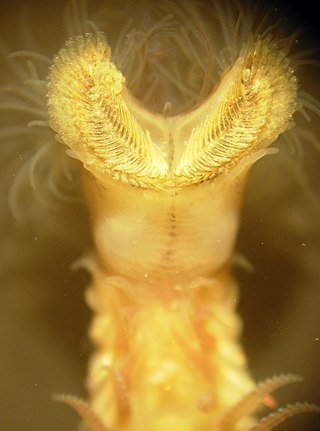
Sabellaria alveolata,, is a reef-forming polychaete. It is distributed around the Mediterranean Sea, and from the north Atlantic Ocean to south Morocco. It is also found in the British Isles at its northern limit in the northeast Atlantic. Its common name is derived from the honeycomb-like pattern it creates when building its tube reefs.

Hydroides norvegica is a species of tube-forming annelid worm in the family Serpulidae. It is found on submerged rocks, shells, piles and boats in many coastal areas around the world. It is the type species of the genus Hydroides.

Chaetopterus variopedatus is a species of parchment worm, a marine polychaete in the family Chaetopteridae. It is found worldwide. However, recent discoveries from molecular phylogeny analysis show that Chaetopterus variopedatus sensu Hartman (1959) is not a single species.

Lanice conchilega, commonly known as the sand mason worm, is a species of burrowing marine polychaete worm. It builds a characteristic tube which projects from the seabed, consisting of cemented sand grains and shell fragments with a fringe at the top.

Lagis koreni, commonly known as the trumpet worm, is a species of marine polychaete worm found in European waters. It lives within a narrow conical tube made of grains of sand and shell fragments.
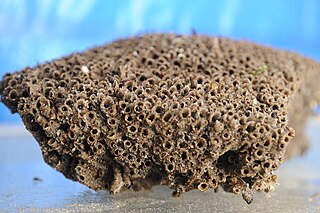
Sabellariidae is a family of marine polychaete worms in the suborder Sabellida. The worms live in tubes made of sand and are filter feeders and detritivores.
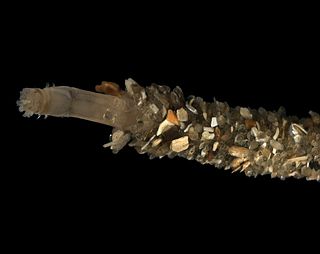
Oweniidae is a family of marine polychaete worms in the suborder Sabellida. The worms live in tubes made of sand and are selective filter feeders, detritivores and grazers.

Eudistylia polymorpha, the giant feather duster worm, is a species of marine polychaete worm belonging to the family Sabellidae. Its common name is from the crown of tentacles extended when the animal is under water.
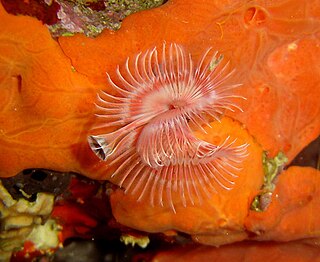
Serpula vermicularis, known by common names including the calcareous tubeworm, fan worm, plume worm or red tube worm, is a species of segmented marine polychaete worm in the family Serpulidae. It is the type species of the genus Serpula and was first described by Carl Linnaeus in his 1767 12th edition of Systema Naturae. It lives in a tube into which it can retract.
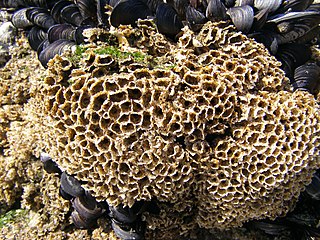
Sabellaria is a genus of marine polychaete worms in the family Sabellariidae. The type species is Sabellaria alveolata. These worms are sedentary and build tubes in which to live from sand and shell fragments. Some species are called honeycomb worms and when they occur in great numbers they can form reefs on rocks and other hard substrates. They are filter feeders, extending a plume-like fan of radioles from the end of the tube in order to catch plankton and detritus floating past. They have a distinctive operculum which is used to block the opening of the tube when the radioles are retracted.
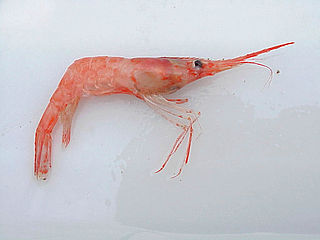
Pandalus is a genus of shrimp in the family Pandalidae. Members of the genus are medium-sized and live on or near the seabed. Some species are the subject of commercial fisheries and are caught by trawling. One species, Pandalus montagui, lives in association with the reef-building polychaete worm, Sabellaria spinulosa.

Pandalus montagui is a species of cold-water shrimp in the family Pandalidae. It is the type species of the genus Pandalus and is variously known as the pink shrimp, Aesop shrimp and Aesop prawn.
Neosabellaria cementarium is a species of marine tube worm in the family Sabellariidae, perhaps better known by its previous name, Sabellaria cementarium. It is found in the North Pacific Ocean.
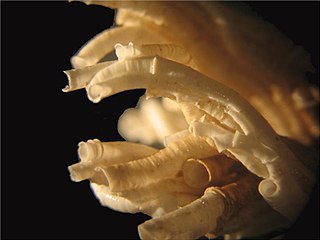
Ficopomatus enigmaticus, commonly known as the Australian tubeworm, is a species of serpulid tubeworms. Their true native range is unknown, but they probably originated in the Southern Hemisphere, perhaps from the Indian Ocean and the coastal waters of Australia. Today they have a cosmopolitan distribution, having been introduced to shallow waters worldwide. The Australian tubeworm is an invasive species that dominates and alters habitats, reduces water quality, depletes resources, and causes biofouling.
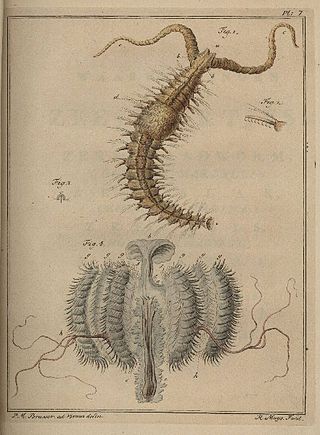
Polydora ciliata is a species of annelid worm in the family Spionidae, commonly known as a bristleworm. It is a burrowing worm and is found in the northeastern Atlantic Ocean and some other parts of the world.
Sabellaria alcocki is a species of bristle worm described by Charles Joseph Gravier in 1906 and named in honour of Alfred William Alcock.
Sabellaria spinulosa and S. alcocki are smaller than S. alveolata and inhabit the subtidal and lower intertidal/sublittoral fringes. Sabellaria spinulosa has been described from the North Sea and S. alcocki from the Indian Ocean.

Poecilochaetus serpens is a species of marine polychaete worm in the family Poecilochaetidae. It is a benthic worm that burrows into soft sediment.


















